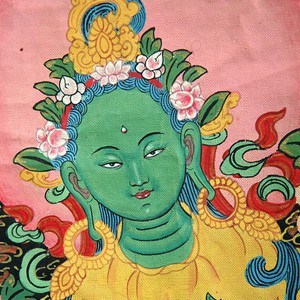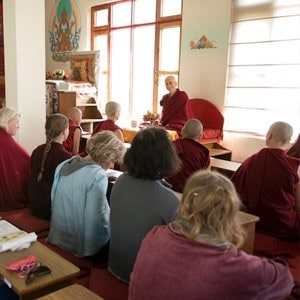Instruction videos on prostrations
Instructions
- How to make prostrations
- What to visualize during the process
Demonstration
- A physical demonstration of how to make prostrations
- How to recite the names of the 35 Buddhas while doing prostrations
The reason we make prostrations is to help us purify our negative karma and help us see the good qualities of the Triple Gem and develop respect and admiration for them. Because when we see the good qualities in others then it opens our own minds to develop those same qualities.
When we bow we visualize in the space in front of us the Buddha and the 34 light rays coming out of his heart with the other 34 Buddhas. [In the 35 buddhas practice.] When we do the prostrations, our right hand symbolizes compassion (or method), and our left hand symbolizes wisdom. When we put them together we’re combining method and wisdom together in one mind.
And when we put hour hands together we have our thumbs tucked in, and so that’s like going to the Buddha holding a jewel. And then the empty space around our hands represents emptiness, the ultimate truth.
When we first start to prostrate we touch our crown, and this symbolizes the crown protrusion that you see on all the Buddha statues, on the top of the head. The Buddha gained that by creating so much merit when he was a bodhisattva. So when we touch our crown it symbolizes that we, too, want to create that much merit and become like the Buddha. So we touch our crown.
Then we touch our forehead. And at that time we imagine white light coming from the foreheads of the buddhas into our forehead and then spreading throughout our body. And this purifies any kind of negativity we’ve created with our body. So, killing, stealing, unwise sexual behavior. And then the light also brings with it all the realizations and inspirations of the Buddha’s physical faculty—the Buddha’s body.
Then we touch our throat and we imagine red light coming from the Buddha’s throat into ours, it purifies the negative karmas we’ve created with speech: lying, divisive words, harsh speech, and idle talk. And it brings the blessings of the Buddha’s verbal faculty—the Buddha’s speech.
Then we touch our heart and we imagine blue light coming from the Buddha’s heart into ours, and that purifies negative actions of mind, such as coveting, ill will, and wrong views. And it brings the blessings of the Buddha’s mental faculty—the Buddha’s mind.
So that’s how we start out the prostration.
Demonstrating prostrations
So when we put our hands together—we put method and wisdom together—then we touch our crown … then we touch our forehead … our throat … our heart … and then we go down and we put our hands down. When we put our hands down our fingers are together. So they’re not spread out and they’re not made into fists, they’re just flat together. And your hands go down before your knees. So you put you hands down, then your knees, step out once with both of your hands at the same time, lie down, stretch your arms out, and then step back once with your hands—move both of your hands back together—step back twice with your hands and push yourself up.
Wile you’re doing this your feet basically stay in the same place. Of course they curl up because you’re lying down.
So let me show you again. So it’s the crown … forehead … throat … heart … hands, knees, hands, lie down, stretch the arms out … step back once with your hands … step back twice with your hands, and then come up.
If you have a prostration board it’s fine to slide down on the board. Otherwise step [with both hands at the same time]. You might want to also have a pad for your knees or for your forehead. When you do a lot of prostrations sometimes they get a little bit sore.
When you’re bowing to each buddha you can do the visualization with the white, red, and blue as I described. Or you can think that when you’re going down just white light is coming and filling you up and purifying, and then when you’re coming up from the prostration that golden light is coming from the Buddha, filling you up and bringing the realizations. So that might be a little bit simpler, rather than the red, white, blue. But you can do either/or, or different ones at different times.
When you do the prostrations you can either make one prostration to each buddha—and while you’re making that one prostration say the name of the buddha many times over and over and over again. So if you do it that way then you know you’ve done 35 prostrations, when you’ve gotten done with the 35 buddhas. So that’s one way to do it.
Another way to do it is to just say the names one right after each other and just prostrate however many times you want to while you’re doing that. That way is a little bit harder to count because you might be doing different numbers of prostrations as you go through the 35 names.
Try and memorize the verses as soon as you can. We’ll make a tape that we’ll put on the website, so you can learn it by practicing with the tape, but then try and memorize the names and the confession prayer—which goes together, the three heap prayer—so it’s confession, rejoicing, dedication. Try and memorize those as soon as you can. Because when you say those, then you also accumulate the good karma verbally, from actually confessing. Whereas if you just let the tape recorder do it, then it may not be coming from your heart, and certainly not coming out of your mouth.
So this is quite a beautiful practice, very inspiring.
When you’re bowing you can also imagine all of your previous lives in human form all around you, filling universes, and that they’re all bowing with you. Or you can imagine all sentient beings surrounding you and they’re all bowing and reciting the names of the buddhas together with you. So it’s really quite a lovely practice to really cleanse a lot of the negativities and obscurations from our mindstream, and develop a lot of faith in the Buddha, but it’s faith that’s based on understanding the Dharma. It’s not undiscriminating belief.
So have a good time on your holiday with the 35 Buddhas. And instead of swimming at the beach with your friends you can go on holiday with the 35 Buddhas, bowing to them the whole way. You’ll get just as much exercise.
Venerable Thubten Chodron
Venerable Chodron emphasizes the practical application of Buddha’s teachings in our daily lives and is especially skilled at explaining them in ways easily understood and practiced by Westerners. She is well known for her warm, humorous, and lucid teachings. She was ordained as a Buddhist nun in 1977 by Kyabje Ling Rinpoche in Dharamsala, India, and in 1986 she received bhikshuni (full) ordination in Taiwan. Read her full bio.


